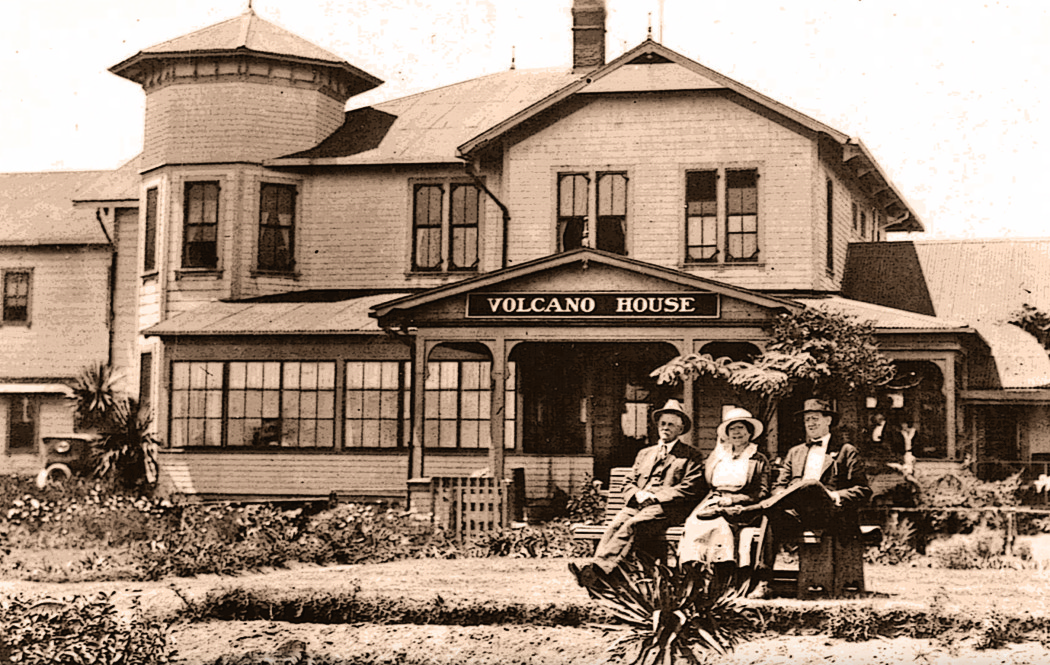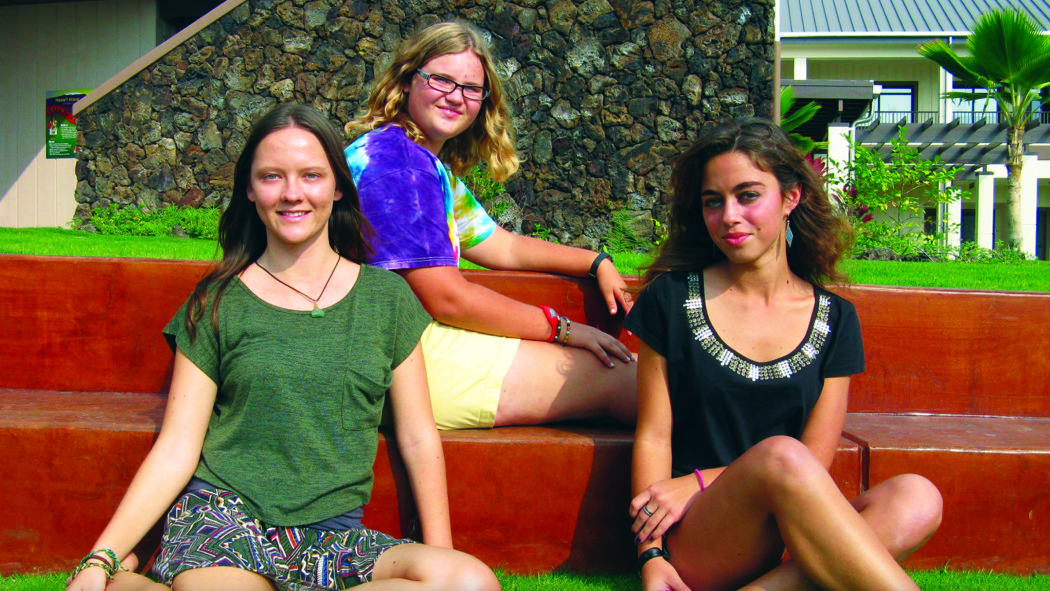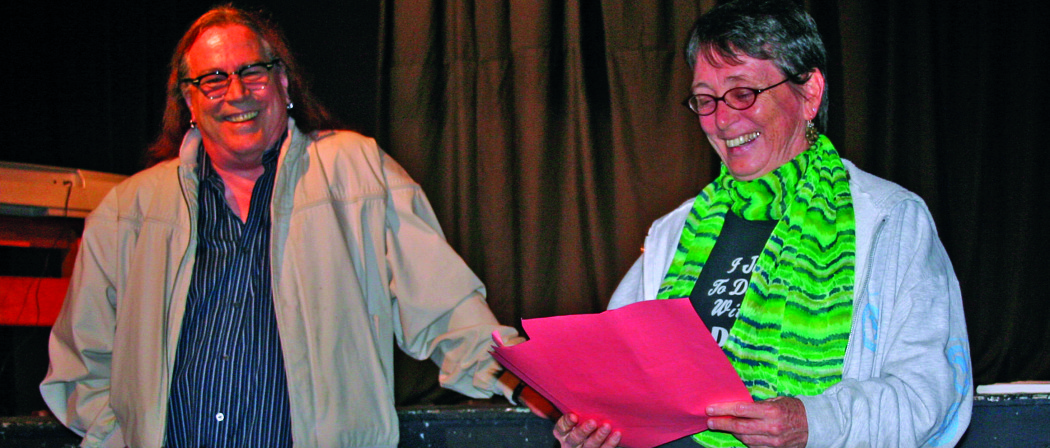
Then & Now: Hawai‘i Volcanoes National Park–100 Years of Witnessing Nature’s Fiery Spectacle
 By Robert Oaks
By Robert Oaks
When westerners first learned about the “Sandwich Islands” in the 1700s, they were fascinated by its massive mountains, Mauna Kea and Mauna Loa, the two tallest mountains on earth at over 31,000 feet when measured from their bases deep beneath the ocean floor. Mauna Loa is also the largest volcano on earth in terms of its sheer mass. It is nearly 100 times the size of Mt. St. Helens in Washington state.
To ancient Hawaiians, Mauna Loa (“long mountain”) was both sacred as home to the goddess Pele and a source for raw materials such as wood for canoes.
The first westerner to attempt to reach the summit of Mauna Loa was John Ledyard, an American serving with Captain James Cook’s third expedition to the Pacific in 1779. He failed. Archibald Menzies, a naturalist and botanist serving with Captain George Vancouver a few years later, also failed in his first two tries to reach the summit in 1793.
Both Ledyard’s and Menzies’ first two tries were from the western side of Mauna Loa, starting out from Kealakekua Bay. On his third attempt, however, Menzies had the support and assistance of King Kamehameha, who advised him to follow the traditional Hawaiian route and approach the mountain from the southeast. This time he succeeded, and Menzies became the first westerner to attain the summit.
Several years later, the English missionary William Ellis became the first westerner to reach Kīlauea. In 1823, he and a few companions made a two-month trip around the island by foot and canoe. Their primary purpose was to find a suitable location to build a mission. Ellis’ account of this journey, published in London two years later, provided a wealth of information about the island, including the first written description of Kīlauea. Upon arriving at the edge of the crater, “a spectacle, sublime and even appalling, presented itself before us…. Astonishment and awe for some moments rendered us mute.” He described a crescent-shaped pit, which he estimated to be two miles in length and 800 feet deep, covered with fiery lava.
Other exploratory expeditions in the early 19th century included those led by Lord George Anson Byron (cousin and successor to the poet), who was assisted by 200 Hawaiians in his trip up Mauna Loa in 1825. In the late 1830s and early 1840s, the United States government sponsored its first international, scientific expedition, sending six ships commanded by Lieutenant Charles Wilkes to the South Pacific. When he reached Hilo in 1840, Wilkes, having read Lord Byron’s account, was ready to climb Mauna Loa. His “caravan,” as he called it, included 200 equipment bearers, 50 food bearers and others who carried a portable house, cookware, tents and knapsacks. There were also many mothers, wives, and children of the bearers accompanying the expedition, often grumbling and complaining along the way.
When they reached Kīlauea’s crater, Wilkes estimated that it was large enough to contain the entire city of New York. As they continued their ascent, many in the party suffered from headaches, fever and dropping temperatures, blisters on their feet when their shoes wore out, and diarrhea. They ultimately reached the summit and spent several days conducting scientific experiments before starting back to Hilo in mid-January 1841. Upon his return to the United States, Wilkes, like Lord Byron before him, published a multi-volume account of his journey.
These accounts soon attracted others to Hawai‘i Island, especially to see the wonders of the volcanoes. By the late 1840s and early 1850s, a few curious souls made the lengthy (and expensive) journey from Honolulu to Hilo and then on to Kīlauea. Few were up to tackling Mauna Loa itself.
In 1846, Benjamin Pitman, Sr. built a grass house at the crater edge and coined the name “Volcano House,” which has remained the name throughout the many manifestations of this rustic inn. In 1866, a more substantial Volcano House was constructed, made of grass and ohia poles, with a parlor, a fireplace and two sleeping rooms. The most famous visitor to this version of Volcano House was Mark Twain, who arrived in July, 1866, as a reporter for the Sacramento Union. His first impression did not live up to his expectations: “a considerable hole in the ground—nothing to Haleakalā [on Maui]—a wide, level black plain in the bottom of it, and a few little sputtering jets of fire….”
Yet the longer he observed, the more he appreciated: “It was growing on me, and tolerably fast.” He was also pleasantly surprised by the Volcano House. “The surprise of finding a good hotel at such an outlandish spot startled me, considerably more than the volcano did.”
Charles Nordhoff, a popular 19th century travel writer, also recommended Kīlauea as a destination, but warned his readers that getting there could be arduous.
There were no hotels in Hilo, so Nordhoff suggested visitors stay with the sheriff, who apparently was a willing host. When leaving Hilo by horseback, Nordhoff warned that the traveler would “leave behind all hope of good roads.” The journey over 30 miles of jagged lava beds with many mud-filled holes meant that the traveler should insist that his horse be re-shod before leaving, and take along an extra pair of horseshoes, and at least a dozen horse-nails. Do not wait for a fine day, he
advised, because it would surely rain at any rate before reaching Volcano House.
Yet, despite the difficulties, after Twain, Nordhoff, and others wrote of their experiences, the number of tourists grew steadily. A new, larger Volcano House opened in 1877 (today the building houses the Volcano Art Center). A regular, once-monthly steamer from Honolulu to Hilo, improved roads, and eventually a small railroad, made the trip much easier. After 1870, mules became the primary mode of transportation to the summit, easing supply logistics somewhat.
The possibility of eruptions undoubtedly attracted some. A huge eruption in 1868 for a time threatened Hilo. Again, in 1880, lava began to flow slowly down the hill, and by the following year, came within seven miles of the town. By then the speed had increased, reportedly moving as rapidly as the Wailuku River. When a day of Christian prayer failed to stem the flow, town residents called upon Princess Ruth Ke’elikōlani to intervene with the goddess Pele.
There are several versions of what happened, but supposedly the formidable Princess threw 30 red silk handkerchiefs, a bottle of brandy (or perhaps it was gin), a pig and a white rooster into the flowing lava, placating Pele, and ending the threat.
Princesses and tourists weren’t the only volcano adventurers; geologists, botanists and other scientists continued to explore Mauna Loa and Kīlauea. In the early 20th century, geologist Thomas A. Jaggar, at different times a professor at both Harvard and M.I.T., pushed for the establishment of a permanent observatory in order to monitor the volcanoes’ activities. Scientists usually arrived on the scene after an eruption, but Jaggar insisted that was too late to learn much. He pushed for both a volcano observatory and the creation of a national park.
Jaggar was aided and supported in this quest by Lorrin A. Thurston, a lawyer, publisher and businessman who had participated in the overthrow of the Hawaiian monarchy in 1893, and who had political connections in both Washington and Honolulu. Their campaign led to the creation—100 years ago this year—of the Hawaiian Volcano Observatory, the first such institution in the United States.
Their campaign also resulted in the creation of Hawai‘i Volcanoes National Park, located in the southeastern portion of Hawai‘i Island, the country’s thirteenth national park established in 1916. In the beginning, the park consisted of just the summits of Kīlauea and Mauna Loa on Hawai‘i Island, as well as Haleakalā on Maui. Over time additional land was added to the park on Hawai‘i Island, and in 1961 Haleakalā was separated to create its own national park. In 1982, Hawai‘i Volcanoes National Park achieved UNESCO’s World Heritage Site status, the only such designation in the State of Hawai‘i.
And finally, in 2003, the National Park Service, in conjunction with the Nature Conservancy, purchased 116,000 acres of Kahuku Ranch, above Highway 11 in Ka’u, increasing the size of the park by 50 percent to over 323,000 acres. The Kahuku Unit, as it is now known, provides hiking trails through old-growth forests, ranch land, historic sites and nature preserves that are very different from the rest of the traditional landscape of the park.
Today the park receives more than 1.3 million visitors each year, many coming to see the activity of Kīlauea, which has been erupting continually since January 1983, allowing visitors to witness an active volcano that has added 500 acres of new land to the island. Especially after dark, it is possible to see the red lava oozing from the earth. During daylight hours, the large plumes of steam created when the lava reaches the ocean are visible from miles away.
The summit of Mauna Loa is more difficult to visit because of the elevation—13,679 feet above sea level, the cold temperatures and the need to hike rather than drive. There are cabins available on a first-come, first-served basis to those who register at the Kīlauea Visitor Center. Although considered an active volcano, Mauna Loa erupted last in 1984.
Contact writer Robert Oaks at boboaks@pacbell.net.
For further reading:
Dougherty, Dennis and Moniz-Nakamura, J., Giant of the Pacific, Mauna Loa Reconnaissance 2003, www.nps.gov/havo/historyculture/upload/Mauna%20Loa%202003.pdf
National Park Service, Hawai‘i Volcanoes National Park, www.nps.gov/havo
Oaks, Robert F. Hawai‘i, A History of the Big Island. Charleston, S.C.: Arcadia Publishing, 2003.
Philbrick, Nathaniel, Sea of Glory, America’s Voyage of Discovery, the U.S. Exploration Expedition, 1838-1842, New York, New York: Penguin Books, 2004.


